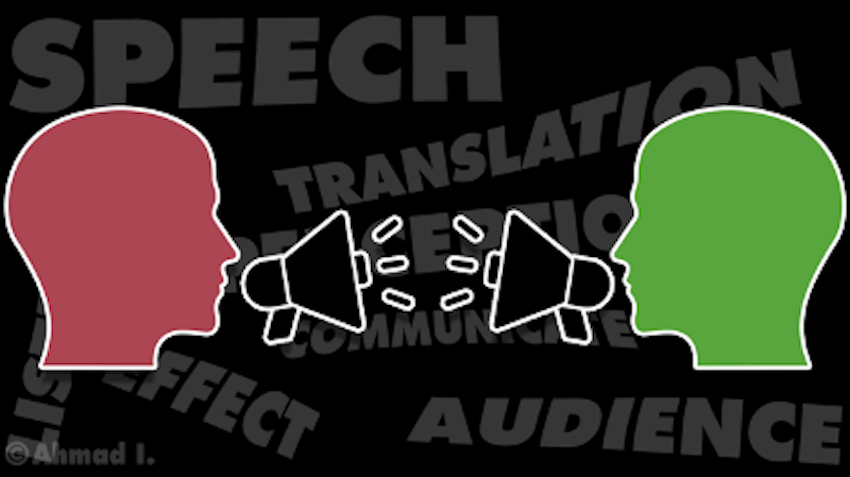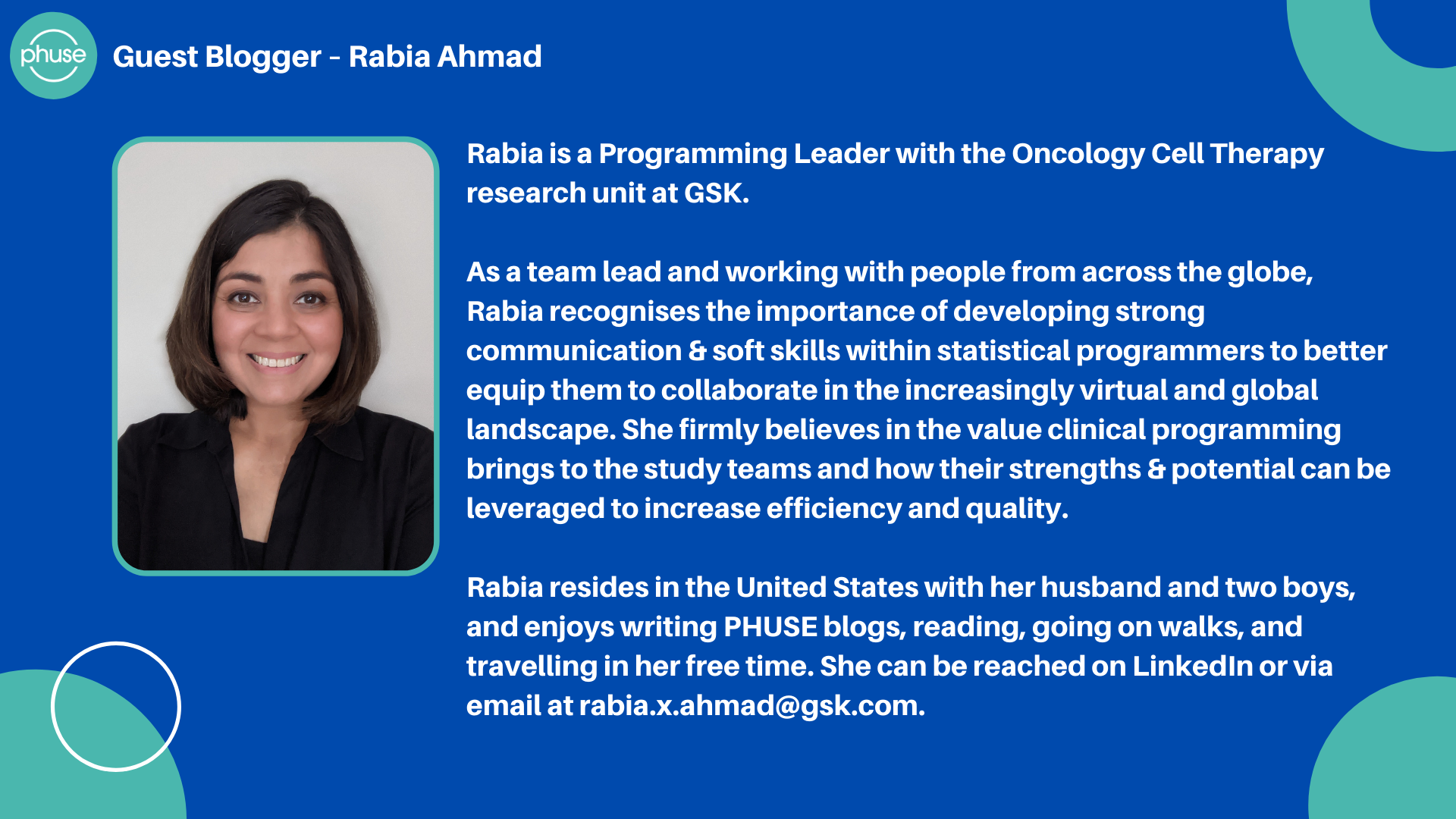Written by Rabia Ahmad, Programming Leader at GSK Please note, this blog is the opinion of the author and does not represent PHUSE nor necessarily the opinion of the authors employer.

Graphic Made by Rabia’s son; Ahmad Imam.
Workplace dynamics have changed drastically in the past decade. We now work remotely, but together; as a unit, but within different functions; communicating thoughts and ideas using a common language, but perceiving them based on our academic, professional, cultural and social experiences. We mostly speak to a phone or a computer screen and, in many cases, have only seen our colleagues on their LinkedIn profile picture. Although the fundamentals of communication have not changed over the years, the act itself has certainly become more complex, layered and idiosyncratic to the role of the communicator and company culture.
In my career as a clinical programmer, team lead and manager, I have found a few communication practices to be of tremendous help when sharing ideas, presenting opinions, mentoring others, working with non-programming functions and managing people and projects. However, before I share these, let’s start with defining the term “effective communication”.
Definition: Effective communication enables sharing of thoughts, concepts and ideas in a complete, clear and concise fashion in order to foster understanding, trust and collaboration within teams and between functions.
Best Practices for Effective Communication:
The “impact” of communication depends on five components: who (speaker), what (content of message), why (reason or context), how (method or style of delivery) and whom (audience).
Self-Assessment
Self-assess how you are perceived by others before sending an email. Actively try to address any gaps in your interpersonal skills. The “who is speaking” matters.
The influence and effectiveness of the message depends on the speaker’s credibility, reliability, technical expertise and seniority. Clinical programmers are experts of data, analysis and reporting and can easily establish their expertise and gravitas in this arena.
Understand the Audience
Do not assume that the audience are mind readers (they aren’t) or can grasp thoughts and intentions when reading an email (they can’t) or can fully assess the body language during a virtual conference (not really) or that English is a universal language (it isn’t).
Every person is different, and individual perception and understanding of what’s written depends on training, culture, language and experiences. Communicating in the global work environment requires careful examination of the sender’s tone, the impact of their role, the relationship between the sender and the recipient and the context of the communication.
A Well-Defined Purpose
Determine the purpose of the communication. Is it a difficult conversation? Does the other person understand programming lingo? Should it be a high-level summary or granular details? What is the role/involvement of the other person in the study team? Is the aim to influence someone towards a particular course of action?
Logically formulate and carefully review the points for accuracy and impact prior to the meeting or hitting the send button on the email. The analytical nature of the clinical programming role automatically lends itself to conversations based on data-driven logic and reasoning. Precise and clear communication should not be the most challenging aspect of interacting with others for clinical programmers!
Clarity & Simplicity of Presentation
Identify the best mode and style of communication. In some cases, brevity is the way to go and in others over communicating is better. Decide whether picking up the phone or allowing the recipient some space to think through their response is the most efficient method to communicate.
Always keep in mind that each layer of separation (face to face vs. remote; email vs. a phone call; direct vs. through an intermediary) between the sender and the recipient ups the chances of misunderstanding. Communication channel and style should be chosen wisely.
Strive to write clear, well-thought-out and proofread emails, always keeping the recipient in mind. Use complete sentences, proper punctuation and correct grammar. Do not hesitate to use an itemised list to organise your thought or content. Avoid using “SAT words”, which require a dictionary for interpretation. Cryptic emails using “text speak”, abbreviations or difficult vocabulary result in confusion and loss of valuable time.
*Remember: in the absence of face-to-face interactions, the email or instant message becomes the medium to convey expectations, sincerity and empathy and trust building. Do not underestimate the power of the written word or the importance of a well-written email or instant message. *
Active Listening
Keep in mind that active listening is crucial to effective communication. This also includes reading emails and messages thoroughly and carefully. It’s important to carefully gauge the mood, expectations, level and diversity of expertise, etc. of the audience and adapt your style accordingly.
The purpose of listening is not only to respond, but to understand and adapt. Listening tells the speaker that their opinions are important and are given due consideration, even if not adopted or acted upon. It conveys respect, builds trusts and is one of the best ways to lead and influence.

I do not exaggerate by saying that each of the best practices outlined above can have its own blog. Some of these (self-assessment, active listening, empathy, clear communication) are not only important for communicating effectively but are also key leadership skills.
To summarise, effective communication helps foster long-term relationships, promotes efficiency, builds collaborative teams and strengthens understanding and trust. On the flip side, its absence results in unhappy (or worse, indifferent) teams, lack of clarity and direction, inefficiencies and loss of knowledge. Think of communicating being no different than programming – the accuracy, clarity and quality of the final report depends on the efficiency and logic of the code used to produce it.
So, how does this impact clinical programmers? If clinical programmers aim to play a more integral role within the broader study team, be independent contributors and decision-makers and grow into senior leadership roles, then they must master the art of effective communication! There are no golden rules for mastering the art of communication, but like any other skill, it can be developed with conscious effort, practice and determination!
References
- Slow down and write better emails. Erica Dhawan. Harvard Business Review. February 19, 2021.
- Secret to Great Communication – Be Like Aristotle. Knowledge at Wharton. September 18, 2018.
- Meetings Would Go Faster if People Took the Time to Listen. Sabina Nawaz. Harvard Business Review. December 12, 2017.
- What Great Listeners Actually Do. Jack Zenger and Joseph Folkman. Harvard Business Review. July 14, 2016.
- 3 Situations Where Cross-Cultural Communication Breaks Down. Ginka Toegel and Jean-Louis Barsoux. Harvard Business Review. June 08, 2016.
- Communication Tips for Global Virtual Teams. Paul Berry. Harvard Business Review. October 30, 2014.
- Three Elements of Great Communication According to Aristotle. Scott Edinger. Harvard Business Review. January 17, 2013.
Author

